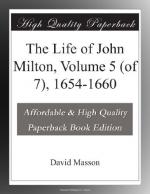authorities, the regular steeple-house clergy whether
Presbyterian or Independent, and the appointed preachers
of all the old sects. By this time, however, he
was by no means the sole preacher of Quakerism.
Every now and then from among his converts there had
started up one fitted to assist him in the work of
itinerant propagandism, and the number of such had
increased in 1654 to about sixty in all. Richard
Farnsworth, James Nayler, William Dewsbury, Thomas
Aldam, John Audland, Francis Howgill, Edward Burrough,
Thomas Taylor, John Camm, Richard Hubberthorn, Miles
Halhead, James Parnel, Thomas Briggs, Robert Widders,
George Whitehead, Thomas Holmes, James Lancaster, Alexander
Parker, William Caton, and John Stubbs, of the one
sex, with Elizabeth Hooton, Anna Downer, Elizabeth
Heavens, Elizabeth Fletcher, Barbara Blaugden, Catherine
Evans, and Sarah Cheevers, of the other sex, were
among the chief of these early Quaker preachers after
Fox. They had carried the doctrines into every
part of England, and also into Scotland and Ireland;
some of them had even been moved to go to the Continent.
Wherever they went there was the same disturbance
round them as round Fox himself, and they had the same
hard treatment—imprisonment, duckings,
whippings. It is necessary that the reader should
remember that in 1654 Quakerism was still in this
first stage of its diffusion by a vehement propagandism
carried on by some sixty itinerant preachers at war
with established habits and customs, and had not settled
down into mere individual Quietism, with associations
of those who had been converted to its principles,
and could be content with their own local meetings.
In the chief centres, indeed, there were now fixed
meetings for the resident Quakers, the main meeting
place for London being the Bull and Mouth in St. Martin’s-le-Grand;
but Fox and most of his coadjutors were still wandering
about the country.—There was already an
extensive literature of Quakerism, consisting of printed
letters and tracts by Fox himself, Farnsworth, Nayler,
Dewsbury, Howgill, and others, and of invectives against
the Quakers and their principles by Presbyterians
and Independents; and some of the letters of the Quakers
had been directly addressed to Cromwell. There
had also, some time in 1654, been one interview between
the Lord Protector and Fox. Colonel Hacker, having
arrested Fox in Leicestershire, had sent him up to
London. Brought to Whitehall, one morning early,
when the Lord Protector was dressing, he had said,
on entering, “Peace be on this House!”
and had then discoursed to the Protector at some length,
the Protector kindly listening, occasionally putting
a question, and several times acknowledging a remark
of George’s by saying it was “very good,”
and “the truth.” At parting, the Protector
had taken hold of his hand, and, with tears in his
eyes, said “Come again to my house! If
thou and I were but an hour of the day together, we
should be nearer one to another. I wish no more
harm to thee than I do to my own soul.”
Outside, the captain on guard, informing George that
he was free, had wanted him, by the Protector’s
orders, to stay and dine with the household; but George
had stoutly declined.[1]




